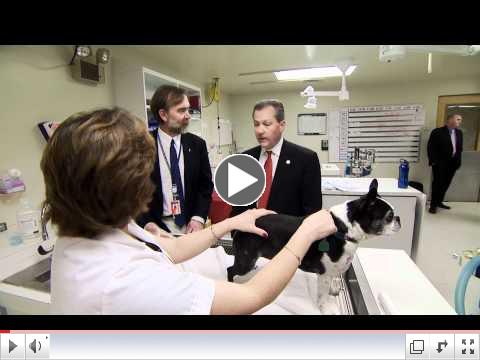|
|
|
|
|
Greetings!
As the Association of American Veterinary Medical Colleges (AAVMC) reported previously, the work of the North American Veterinary Medical Education Consortium (NAVMEC) to prepare for the future of veterinary medical education is already reaping benefits. Initiatives and coalitions are emerging in ways that seem spontaneous, but that adhere in striking ways to the recommendations contained in NAVMEC's Roadmap for Veterinary Medical Education in the 21st Century: Responsive, Collaborative, Flexible. Some of these trends were already under way, but NAVMEC strengthened the focus and got people thinking in ways that resulted in plans and actions that are already taking place.
This ebulletin will provide periodic NAVMEC progress reports with examples of developments in veterinary medical education that align with NAVMEC's goals and 23 recommendations. The diversity of these and previous examples reaffirms NAVMEC's non-prescriptive approach, which enables each institution to pursue NAVMEC's vision in unique and individualized ways.
 |
|
Auburn Launches One Health Cancer Initiative
 | | Auburn initiative will accelerate cancer innovation. |
The Auburn University College of Veterinary Medicine has launched a new initiative to accelerate cancer innovation from the laboratory to the clinic. In a March 16 press release, Auburn announced that The Auburn University Research Initiative in Cancer, or AURIC, embodies the "One Medicine" concept which links human, animal, and environmental health, and where discoveries in one species advance health in all species. "In 2010, more than 23,000 new cases of cancer were diagnosed and more than 10,000 people died of cancer in Alabama," said Bruce Smith, AURIC director. "In addition to being ill with cancer or seeing relatives endure pain, many Alabamians have also watched a beloved pet suffer from this disease. Animals and humans share many of the same cancers and what we learn in treating a tumor in a dog can teach us more about treating the same tumor in a person."
"AURIC will build on the college's existing strengths in nanotherapeutics, nanomedicine, cancer genetics, gene targeting and the capacity to develop translational models," said Calvin Johnson, acting dean of Auburn's College of Veterinary Medicine.
Learn More...
Aligns with NAVMEC strategic goal: Stimulate a profession-wide focus on innovation, flexibility and action.
Aligns with recommendation: 6.2.4 Incorporate concepts of One Health into the veterinary medical curriculum.
|
COE Strengthens Requirements for Research Skills
The Council on Education (COE), responding to input from deans and others, strengthened the language related to research competency. The COE believes that veterinary students should "learn how to critically analyze and interpret research findings," wrote Sheila Allen, dean of the College of Veterinary Medicine at the University of Georgia. The language was changed accordingly, to reflect that integrating a high-quality research program into the veterinary medical curriculum is required, not desired.  | |
Photo: Purdue University College of Veterinary Medicine
|
Outcomes assessment results must be used to improve the college programs and "must be measured, analyzed, and considered to improve the program. Student achievement during the preclinical and clinical curriculum and after graduation must be included in outcome assessment. New graduates must have the basic scientific knowledge, skills, and values to provide entry-level health care, independently, at the time of graduation."
The school/college must develop relevant measures and provide evidence that students/graduates have attained the following competencies: - Comprehensive patient diagnosis (problem solving skills), appropriate use of clinical laboratory testing, and record management
- Comprehensive treatment planning including patient referral when indicated
- Anesthesia and pain management, patient welfare
- Basic surgery skills, experience, and case management
- Basic medicine skills, experience and case management
- Emergency and intensive care case management
- Health promotion, disease prevention/biosecurity, zoonosis, and food safety
- Client communications and ethical conduct
- Critical analysis of new information and research findings relevant to veterinary medicine
Aligns with NAVMEC strategic goal: Graduate career-ready veterinarians who are proficient in and have the confidence to use an agreed-upon set of core competencies.
Aligns with recommendation: 6.1.2 Use NAVMEC core competencies to guide curricula.
|
|
The Importance of Communications Competency Emerges as a Recurrent Theme
No matter what the context lately, there seems to be a recurrent subtext - communication. During the AAVMC's 2012 Annual Conference, presenters repeatedly mentioned the important role that communication skills play in everything from food supply veterinary medicine to persuading clients about the importance of preventive pet healthcare.
The call for communication competency in veterinary medical education is definitely coming to the forefront.
 | |
Photo: College of Veterinary Medicine, Western University College of Health Sciences
|
For example, The Outlook, a publication of the College of Veterinary Medicine, Western University School of Health Sciences, recently featured a story on "The Art of Communication," about a CVM course at Western that teaches the communication skills students can use to build an effective veterinary-client relationship.
"The value of communication cannot be overrated. It makes a huge difference," said Professor Beth Boynton, who works with students in developing key areas of communication: open-ended questions, reflective listening, attention to body language, and empathetic comments. She stresses techniques, such as letting the client tell their story instead of interrupting and displaying empathy, which, said Boynton, "calls for the veterinarian to understand what experience is or was for the client at multiple levels."
Methods for improving communications skills include discussion and analysis of presentations, film clips and the simulation of real scenarios using both self and peer evaluation.
Aligns with NAVMEC strategic goal: Graduate career-ready veterinarians who are proficient in and have the confidence to use an agreed-upon set of core competencies.
Aligns with recommendation: 6.1.2 Use NAVMEC core competencies to guide curricula |
Share Your Examples
If you have examples of ways that your school or college is fulfilling NAVMEC's vision, we'd love to hear about them. Please email jjohnson@aavmc.org and let us know. |
|
|
|
|
|
|
|
|
|
|